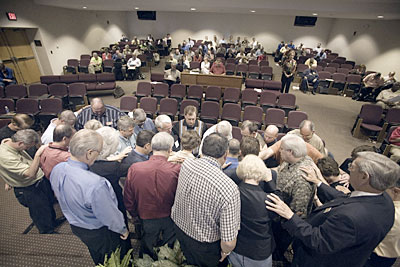Many Southern Baptist churches that pride themselves in being “missions-minded” might have a hard time convincing an impartial observer, an International Mission Board leader told trustees Sept. 12 at LifeWay Ridgecrest (N.C.) Conference Center.
 IMB trustees and staff pray for the newly elected leader of Southern Baptist work in East Asia and his wife during their Sept. 12 meeting at LifeWay Ridgecrest (N.C.) Conference Center. The new leader’s name was withheld from publication for security reasons.
IMB trustees and staff pray for the newly elected leader of Southern Baptist work in East Asia and his wife during their Sept. 12 meeting at LifeWay Ridgecrest (N.C.) Conference Center. The new leader’s name was withheld from publication for security reasons.The meeting was part of a three-day gathering that included a national reunion for about 1,000 emeritus missionaries at Ridgecrest and the appointment of 48 new overseas workers at Biltmore Baptist Church in Arden near Asheville.
“As I travel, I hear a lot about how ‘missions-minded’ Southern Baptists are,” said Gordon Fort, IMB vice president of overseas operations. “I often ask, ‘How much does your church pay for utilities each year?’ Then I ask, ‘If you are paying more for your utility bill than you are giving to reach a lost world for Christ, how does that make you a missions-minded church?'”
Southern Baptist churches ought to reexamine just how high a priority missions really is when they claim a total of 16 million members, yet have only 5,234 international personnel currently under appointment, Fort said.
“Southern Baptists are great to talk about tithing,” he told the trustees. “I want to ask whether a church shouldn’t tithe its membership to reach a lost world?” Even if just 1 percent of 10 million active Southern Baptists were to enter the mission force, “we would have 100,000 missionaries. Instead, we have 5,000.”
Fort noted that IMB leaders have a vision “for 3,000 more active missionaries on the field. … Adding 3,000 new missionaries might be a difficult task if we were starting out with no resources, but the truth is that those 3,000 new missionaries are already sitting in our churches, and the finances to support them are already in our pockets. It’s not a hard task.”
During their May 2007 meeting, IMB trustees allocated $5.2 million beyond what was already budgeted to fund new missionaries using 2006 Lottie Moon Christmas Offering receipts to enable sending an additional 200 new missionaries to the field in 2007-2008.
A key strategy for recruiting 3,000 additional missionaries is a new emphasis on mobilizing students for “hands on” missions, Fort said.
The pilot project – “Hands On: Africa” – will give 18- to 29-year-olds an opportunity to immerse themselves in the “nuts and bolts” of overseas missions for four or five months while working alongside seasoned workers in a wide range of missions challenges. Applications for spring 2008 projects are due Oct. 20. The program is expected to expand to other parts of the world by 2009.
“I find a tremendous responsiveness to missions in the hearts of young people today. They want to make a difference,” Fort said. “I believe that if we can connect our young people to the reality of overseas service, God will speak to many of them, and we will see them come back as journeyman and career missionaries.”
‘Harvest fields’
The new generation of Southern Baptist overseas missionaries is learning that the responsiveness of groups is directly related to their access to the gospel, IMB president Jerry Rankin said.
People have long talked about the work of missionaries in terms of “sowing fields” (places where the gospel is shared but people have not yet responded) and “harvest fields” (places where people are responding in great numbers to gospel proclamation), Rankin said. The truth, however, is there are only “current harvest fields” and “neglected harvest fields.”
“Harvest, or responsiveness, is always linked to access,” Rankin said. “There is no harvest where there is no proclamation.”